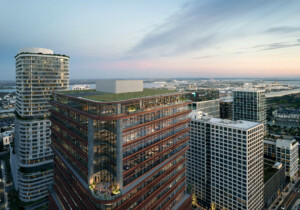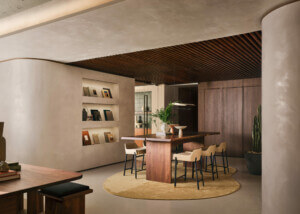In pondering the post-2025 office of the future, global architecture firm NBBJ believes in the power of “nudge architecture” as a counterpoint to alienating corporate culture and sedentary cubicle lifestyles.
Asked by Fast Company to envisage the workplace a decade from now, the firm responded with a design where fitness and face-to-face social interactions are at the forefront. The firm projected bike paths throughout the building that would allow workers to ride their bikes right up to their desks, with ramps at every entrance.
“The key ingredient is mobility, as we’re going to be wearing our computers, screens and everything else,” said NBBJ chair and partner Scott Wyatt. “But even today we have spectacular mobility as we aren’t chained to desks, file cabinets and computers. We can start to create spaces that better respond to human needs.”
In a bid to dissipate hierarchical divides, stairs and elevators will be eliminated in favor of building atop a seamless, switch-backing incline. This graded layout means no more ensconcing of respective departments – Finance, HR, Management and Sales will have to learn to tolerate one another’s society. Ramps leading from one staggered “level” to the next create “extensive sight lines” where co-workers have more opportunity to interact, maintains NBBJ.
According to Fast Company, the idea riffs off the long-held ‘Allen Curve’ theory, which estimates that workers are four times more likely to communicate with someone who is six feet away than a colleague who is 60 feet away, and unlikely to ever debrief at the water cooler with someone on another floor. The firm’s more conventional suggestions include bringing the outdoors indoors with exposure to indoor plants and natural light. There is talk of using dynamically shaded glass that adapts to changes in brightness gradations – which could allow for an all-glass edifice (roof included).
NBBJ gets sci-fi creative with its suggestions of a building that is entirely responsive to user’s needs. As an example, the firm envisions sensors that differentiate between quiet and loud zones. This information is then relayed to a computer that shifts the floor plates accordingly to shape these spaces in real-time.
The firm takes the mobility concept further with conference rooms that not only self-assemble when needed, but can migrate workers around large complexes during meetings so that you don’t need to walk from one building to another in a large campus-style office. The focus is on space-saving economies, said NBBJ partner Ryan Mullenix – and not yet another technological invention providing a ready excuse not to walk. “When you don’t have to fill 50 percent of your space with conference rooms, things can begin to move.”










